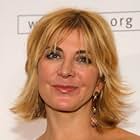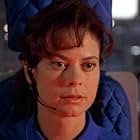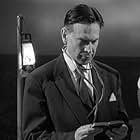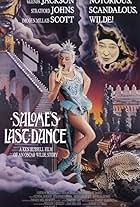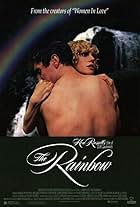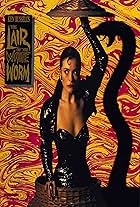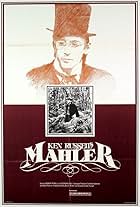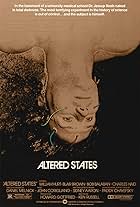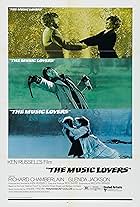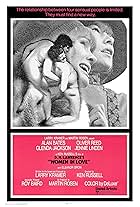IMDb RATING
5.7/10
9.2K
YOUR RATING
The Shelleys visit Lord Byron and compete to write a horror story.The Shelleys visit Lord Byron and compete to write a horror story.The Shelleys visit Lord Byron and compete to write a horror story.
- Awards
- 2 wins & 2 nominations
Chris Chappell
- Man in Armour
- (as Chris Chappel)
Cosey Fanni Tutti
- Shelley Fan
- (as Christine Newby)
Kim Tillesly
- Shelley Fan
- (as Kim Tillesley)
Ken Russell
- Tourist
- (uncredited)
- Director
- Writers
- All cast & crew
- Production, box office & more at IMDbPro
Storyline
Did you know
- TriviaThe painting that Mary Shelley sees on the wall, and that subsequently comes to life in her dream, is Henry Fuseli's "Nightmare."
- GoofsClaire Clairmont (Myriam Cyr) falls out of the rowboat in the opening scene, but just a few seconds later, as she's running with Percy toward the house, her clothes and hair are totally dry.
- Quotes
[first lines]
Tour Guide: And there, ladies and gentlemen, on the other side of the lake we have the famous Villa Diodati where Lord Byron, greatest living English poet, resides in exile. Romantic, scholar, duelist, best-selling author of Childe Harold, he was forced to leave his native land after many scandals including incest and adultery with Lady Caroline Lamb. "Mad, bad and dangerous to know" she called him.
[the guide squeezes a lady's hand and points]
Tour Guide: Bedroom - top right.
- Alternate versionsAmerican versions contain a title-card before the credits. This title card contains Mary Shelley's quote from the foreword to Frankenstein where she discusses the night the movie centers around. A brief explanation is then provided mentioning that both Frankenstein and Dracula were born on that night.
- ConnectionsFeatured in Siskel & Ebert: Project X/Wild Thing/Heaven/Gothic (1987)
Featured review
It must be said, I love the work of Ken Russell. If he were of any other nationality or generation he'd be subject to a veritable tome of critical analysis; with amazing films like Elgar (1962), The Debussy Film (1965), Women in Love (1969), The Devils (1971) and Savage Messiah (1972) all standing out as some of the most radical, imaginative and visually impressive feature films of the last fifty years. Too often his excesses got the better of him, as in films such as Lisztomania (1975), The Lair of the White Worm (1987) and Salome's Last Dance (1988), but despite the overall quality of those films, the results were always interesting and visually unforgettable. Gothic (1986) has much in common with the latter collection of works, being somewhat messy and decadent whilst still trying to remain somewhat conventional in its approach to character and narrative. It is this aspect of the film that is the weakest, with the story and the characterisation often feeling somewhat weak or unformed, particularly in the first half. However, once the film gets going - and the wild images and hallucinations begin to accumulate - Russell's energetic style and talent for creating outré and unforgettable visual compositions and ideas really begins to take off; creating a film that is fascinating and open to deeper interpretations regarding the character of Mary Shelley and the unfortunate circumstances of her life that may have led to the creation of her classic and iconic horror story, Frankenstein.
Naturally, the roots of the film are based in fact, taking place in June of 1816 - the "year without summer" - when the five central characters met at Lord Byron's Villa Diodati by Lake Geneva. From here, the film creates a fictional back-story to the wet and windy night that would give birth, not only to Shelley's Frankenstein, but also Polidori's celebrated novel, The Vampyre. What follows is a bizarre and overwhelming example of pure visual storytelling, which is all the more impressive when you take into account the obviously limited budget. However, if you can overcome this aspect - as well as the rather poor performances from Julian Sands as the exaggerated Percy Shelley and Myriam Cyr as Mary's half-sister Claire Clairmont - then the film will reward with a truly astounding final act filled with Russell's typically surreal and lurid imagery, an escalating sense of fever-dream-like horror and exaggeration and the three fine performances from Gabriel Byrne as the seductive Lord Byron, Natasha Richardson as the tortured Mary Shelly and Timothy Spall as the beleaguered Dr. John William Polidori. The tension is also heightened by the choice of location, with the film taking place almost entirely within the Byron estate, and almost entirely at night; although there are two separate framing devises, one of which takes place in the present-day and helps clarify some of the scenarios depicted in the film's aforementioned final act.
These don't necessarily add much to the story - though neither do they detract - simply giving a certain sense of context before Russell gets on with the mind-blowing imagery and finely tuned atmosphere of eroticised dread. Some have likened the film to Dario Argento's classic supernatural thriller Suspiria (1977), with the use of Gothic locations, bold colours and a self-consciously visual approach to storytelling. These similarities stand, though you can also see the film as an extension of the earlier Altered States (1980) and Crimes of Passion (1984); both in certain thematic preoccupations, and in the actual visual presentation overall. The film works simply because of the intensity of the images, but ultimately going deeper than even that; tying the whole thing into the character of Mary Shelley and her own sense of personal tragedy. It gives the film that much needed emotional quality, helped along by the fine performance from the incredibly young Richardson in one of her first leading roles. She's complimented well by Byrne, who takes the role of Byron entirely seriously, even when spouting some incredibly pretentious dialog and attempting to seduce every character in the film. Nonetheless, the intensity of the role shines through and really establishes the character, with his fears and weaknesses going towards the creation of his own personal nightmare that will reverberate through time.
The film suggests that by raising the spirits of the dead you fate yourself to an inescapable evil. This is reflected by the tragic circumstances that surrounded the characters - hinted at in that tour-de-force final - and their eventual fate as documented by history itself. It's very clever once you get past the awkward, slightly giddy and anachronistic-like feeling of the first few scenes and really get into the horror aspect and the more much rewarding sense of human interest. Naturally, it won't be to all tastes, as the factors that Russell tends to highlight in his work - religious symbolism, garishness, sex and sensuality, brutality and anachronistic humour - will obviously cause problems for viewers looking for a more conventional "horror" story. I liked the break in convention, though. After all, there are plenty of horror films that regurgitate the same old stock tactics and scenarios. Gothic goes for a different approach; one that is more eccentric, single-minded and unique, layering the fact and fantasy elements of Stephen Volk's imaginative screenplay with a lurid and sensational approach to the visual telling of the story, rife with his usual themes and obsessions. If you love Russell's work, and appreciate interesting and unconventional cinema, then Gothic is well worth checking out; if not for the bizarre visual aspects and exciting, nightmarish final, then certainly for the nicely judged performances of Richardson, Byrne and Spall.
Naturally, the roots of the film are based in fact, taking place in June of 1816 - the "year without summer" - when the five central characters met at Lord Byron's Villa Diodati by Lake Geneva. From here, the film creates a fictional back-story to the wet and windy night that would give birth, not only to Shelley's Frankenstein, but also Polidori's celebrated novel, The Vampyre. What follows is a bizarre and overwhelming example of pure visual storytelling, which is all the more impressive when you take into account the obviously limited budget. However, if you can overcome this aspect - as well as the rather poor performances from Julian Sands as the exaggerated Percy Shelley and Myriam Cyr as Mary's half-sister Claire Clairmont - then the film will reward with a truly astounding final act filled with Russell's typically surreal and lurid imagery, an escalating sense of fever-dream-like horror and exaggeration and the three fine performances from Gabriel Byrne as the seductive Lord Byron, Natasha Richardson as the tortured Mary Shelly and Timothy Spall as the beleaguered Dr. John William Polidori. The tension is also heightened by the choice of location, with the film taking place almost entirely within the Byron estate, and almost entirely at night; although there are two separate framing devises, one of which takes place in the present-day and helps clarify some of the scenarios depicted in the film's aforementioned final act.
These don't necessarily add much to the story - though neither do they detract - simply giving a certain sense of context before Russell gets on with the mind-blowing imagery and finely tuned atmosphere of eroticised dread. Some have likened the film to Dario Argento's classic supernatural thriller Suspiria (1977), with the use of Gothic locations, bold colours and a self-consciously visual approach to storytelling. These similarities stand, though you can also see the film as an extension of the earlier Altered States (1980) and Crimes of Passion (1984); both in certain thematic preoccupations, and in the actual visual presentation overall. The film works simply because of the intensity of the images, but ultimately going deeper than even that; tying the whole thing into the character of Mary Shelley and her own sense of personal tragedy. It gives the film that much needed emotional quality, helped along by the fine performance from the incredibly young Richardson in one of her first leading roles. She's complimented well by Byrne, who takes the role of Byron entirely seriously, even when spouting some incredibly pretentious dialog and attempting to seduce every character in the film. Nonetheless, the intensity of the role shines through and really establishes the character, with his fears and weaknesses going towards the creation of his own personal nightmare that will reverberate through time.
The film suggests that by raising the spirits of the dead you fate yourself to an inescapable evil. This is reflected by the tragic circumstances that surrounded the characters - hinted at in that tour-de-force final - and their eventual fate as documented by history itself. It's very clever once you get past the awkward, slightly giddy and anachronistic-like feeling of the first few scenes and really get into the horror aspect and the more much rewarding sense of human interest. Naturally, it won't be to all tastes, as the factors that Russell tends to highlight in his work - religious symbolism, garishness, sex and sensuality, brutality and anachronistic humour - will obviously cause problems for viewers looking for a more conventional "horror" story. I liked the break in convention, though. After all, there are plenty of horror films that regurgitate the same old stock tactics and scenarios. Gothic goes for a different approach; one that is more eccentric, single-minded and unique, layering the fact and fantasy elements of Stephen Volk's imaginative screenplay with a lurid and sensational approach to the visual telling of the story, rife with his usual themes and obsessions. If you love Russell's work, and appreciate interesting and unconventional cinema, then Gothic is well worth checking out; if not for the bizarre visual aspects and exciting, nightmarish final, then certainly for the nicely judged performances of Richardson, Byrne and Spall.
- ThreeSadTigers
- Jun 2, 2008
- Permalink
- How long is Gothic?Powered by Alexa
Details
Box office
- Gross US & Canada
- $916,172
- Opening weekend US & Canada
- $32,061
- Apr 12, 1987
- Gross worldwide
- $916,172
- Runtime1 hour 27 minutes
- Sound mix
- Aspect ratio
- 1.85 : 1
Contribute to this page
Suggest an edit or add missing content












